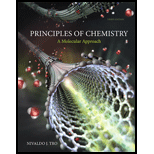
Concept explainers
For each precipitation reaction, calculate how many grams of the first reactant are necessary to completely react with 55.8 g of the second reactant.
a.
b.
c.
Want to see the full answer?
Check out a sample textbook solution
Chapter 4 Solutions
Principles of Chemistry: A Molecular Approach (3rd Edition)
- Determine the volume of sodium hydroxide solution needed to prepare 26.2 g sodium phosphate, Na3PO4, by the reaction 3NaOH(aq)+H3PO4(aq)Na3PO4(aq)+3H2O(l) The sodium hydroxide solution, whose density is 1.133 g/mL, contains 12.0% NaOH by mass.arrow_forwardDetermine the volume of sulfuric acid solution needed to prepare 37.4 g of aluminum sulfate, Al2(SO4)3, by the reaction 2Al(s)+3H2SO4(aq)Al2(SO4)3(aq)+3H2(g) The sulfuric acid solution, whose density is 1.104 g/mL, contains 15.0% H2SO4 by mass.arrow_forwardThe formation of water-Insoluble silver chloride is useful in the analysis of chloride-containing substances. Consider the following unbalanced equation: BaCl2(aq) + AgNO3(aq) AgCI(s) + Ba(NO3)2(aq) (a) Write the balanced equation. (b) What mass of AgNO3, in grams, is required for complete reaction with 0.156 g of BaCI2? What mass of AgCI is produced?arrow_forward
- Twenty-five mL of a 0.388 M solution of Na2SO4 is mixed with 35.3 mL of 0.229 M Na2SO4. What is the molarity of the resulting solution? Assume that the volumes are additive.arrow_forwardDisulfur dichloride, S2Cl2, is used to vulcanize rubber. It can be made by treating molten sulfur with gaseous chlorine. S8() + 4 Cl2(g) 4 S2Cl2(g) Complete this table of reaction quantities for the production of 103.5 g S2Cl2.arrow_forwardChlorine gas was first prepared in 1774 by C. W. Scheele by oxidizing sodium chloride with manganese(IV) oxide. The reaction is NaCl(aq) + H2SO4(aq) + MnO2(s) Na2SO4(aq) + MnCl2(aq) + H2O(l) + Cl2 (g) Balance this equation.arrow_forward
- Potassium hydrogen phthalate, KHC8H4O4, is used to standardize solutions of bases. The acidic anion reacts with bases according to this net ionic equation: A 0.902-g sample of potassium hydrogen phthalate requires 26.45 mL NaOH to react; determine the molarity of the NaOH.arrow_forwardn general terms, what are the spectator ions in a precipitation reaction? Why are the spectator ions not included in writing the net ionic equation for a precipitation reaction? Does this mean that the spectator ions do not have to be present in the solution?arrow_forwardElemental bromine is the source of bromine compounds. The element is produced from certain brine solutions that occur naturally. These brines are essentially solutions of calcium bromide that, when treated with chlorine gas, yield bromine in a displacement reaction. What are the molecular equation and net ionic equation for the reaction? A solution containing 40.0 g of calcium bromide requires 14.2 g of chlorine to react completely with it, and 22.2 g of calcium chloride is produced in addition to whatever bromine is obtained. How many grams of calcium bromide are required to produce 10.0 pounds of bromine?arrow_forward
- 39. Standard solutions of calcium ion used to test for water hardness are prepared by dissolving pure calcium carbonate. CaCO3, in dilute hydrochloric acid. A 1.745-g sample of CaCO3 is placed in a 250.O-mL volumetric flask and dissolved in HCI. Then the solution is diluted to the calibration mark of the volumetric flask. Calculate the resulting molarity of calcium ion.arrow_forwardCitric acid, which can be obtained from lemon juice, has the molecular formula C6H8O7. A 0.250-g sample of citric acid dissolved in 25.0 mL of water requires 37.2 mL of 0.105 M NaOH for complete neutralization. What number of acidic hydrogens per molecule does citric acid have?arrow_forwardPotassium hydrogen phthalate, KHCgH4O4, is used to standardize solutions of bases. The acidic anion reacts with strong bases according to the following net ionic equation: HCgH4O4(aq) + OH(aq) CgH4O42(aq) + H2O(l) If a 0.902-g sample of potassium hydrogen phthalate is dissolved in water and titrated to the equivalence point with 26.45 mL of NaOH(aq), what is the molar concentration of the NaOH?arrow_forward
 Chemistry: The Molecular ScienceChemistryISBN:9781285199047Author:John W. Moore, Conrad L. StanitskiPublisher:Cengage Learning
Chemistry: The Molecular ScienceChemistryISBN:9781285199047Author:John W. Moore, Conrad L. StanitskiPublisher:Cengage Learning Chemistry & Chemical ReactivityChemistryISBN:9781337399074Author:John C. Kotz, Paul M. Treichel, John Townsend, David TreichelPublisher:Cengage Learning
Chemistry & Chemical ReactivityChemistryISBN:9781337399074Author:John C. Kotz, Paul M. Treichel, John Townsend, David TreichelPublisher:Cengage Learning Chemistry & Chemical ReactivityChemistryISBN:9781133949640Author:John C. Kotz, Paul M. Treichel, John Townsend, David TreichelPublisher:Cengage Learning
Chemistry & Chemical ReactivityChemistryISBN:9781133949640Author:John C. Kotz, Paul M. Treichel, John Townsend, David TreichelPublisher:Cengage Learning General Chemistry - Standalone book (MindTap Cour...ChemistryISBN:9781305580343Author:Steven D. Gammon, Ebbing, Darrell Ebbing, Steven D., Darrell; Gammon, Darrell Ebbing; Steven D. Gammon, Darrell D.; Gammon, Ebbing; Steven D. Gammon; DarrellPublisher:Cengage Learning
General Chemistry - Standalone book (MindTap Cour...ChemistryISBN:9781305580343Author:Steven D. Gammon, Ebbing, Darrell Ebbing, Steven D., Darrell; Gammon, Darrell Ebbing; Steven D. Gammon, Darrell D.; Gammon, Ebbing; Steven D. Gammon; DarrellPublisher:Cengage Learning Chemistry for Engineering StudentsChemistryISBN:9781337398909Author:Lawrence S. Brown, Tom HolmePublisher:Cengage Learning
Chemistry for Engineering StudentsChemistryISBN:9781337398909Author:Lawrence S. Brown, Tom HolmePublisher:Cengage Learning ChemistryChemistryISBN:9781305957404Author:Steven S. Zumdahl, Susan A. Zumdahl, Donald J. DeCostePublisher:Cengage Learning
ChemistryChemistryISBN:9781305957404Author:Steven S. Zumdahl, Susan A. Zumdahl, Donald J. DeCostePublisher:Cengage Learning





